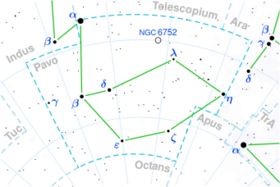Astronomy:Beta Pavonis
| Observation data Equinox J2000.0]] (ICRS) | |
|---|---|
| Constellation | Pavo |
| Right ascension | 20h 44m 57.49399s[1] |
| Declination | −66° 12′ 11.5708″[1] |
| Apparent magnitude (V) | 3.42[2] |
| Characteristics | |
| Spectral type | A5 IV[3] or A7 III[4] |
| U−B color index | +0.12[5] |
| B−V color index | +0.16[5] |
| Astrometry | |
| Radial velocity (Rv) | +3.7±0.5[6] km/s |
| Proper motion (μ) | RA: −42.67[1] mas/yr Dec.: +9.94[1] mas/yr |
| Parallax (π) | 24.14 ± 0.16[1] mas |
| Distance | 135.1 ± 0.9 ly (41.4 ± 0.3 pc) |
| Absolute magnitude (MV) | +0.33[2] |
| Details | |
| Mass | 2.51[3] M☉ |
| Radius | 2.3[7] R☉ |
| Luminosity | 66[3] L☉ |
| Surface gravity (log g) | 3.84[8] cgs |
| Temperature | 8,184±278[8] K |
| Rotational velocity (v sin i) | 75[3] km/s |
| Age | 305[8] Myr |
| Other designations | |
| Database references | |
| SIMBAD | data |
Beta Pavonis, Latinised from β Pavonis, is a single,[9] white-hued star in the southern constellation of Pavo. It can be seen with the naked eye, having an apparent visual magnitude of 3.42.[2] Based upon an annual parallax shift of 24.14 mas as seen from Earth, it is located 135 light-years from the Sun. It is moving away from the Sun with a radial velocity of +4 km/s.[6] Beta Pavonis is a member of the Ursa Major Moving Group, a set of stars that share a similar motion through space.[10]
Zorec and Royer (2012) list a stellar classification for this star of A5 IV,[3] indicating it is an evolving subgiant star that has consumed the hydrogen at its core and has begun to expand onto the red giant branch. However, Houk (1979) listed a more evolved class of A7 III,[4] suggesting it is already a giant star. It has about 2.3[7] times the Sun's radius and 2.51[3] times the mass of the Sun. At the estimated age of 305[8] million years, the star still has a relatively high rate of spin, having a projected rotational velocity of 75 km/s.[3] Beta Pavonis is radiating 66[3] times the Sun's luminosity from its photosphere at an effective temperature of about 8,184 K.[8]
References
- ↑ 1.0 1.1 1.2 1.3 1.4 Van Leeuwen, F. (2007). "Validation of the new Hipparcos reduction". Astronomy and Astrophysics 474 (2): 653–664. doi:10.1051/0004-6361:20078357. Bibcode: 2007A&A...474..653V. Vizier catalog entry
- ↑ 2.0 2.1 2.2 Anderson, E.; Francis, Ch. (2012). "XHIP: An extended hipparcos compilation". Astronomy Letters 38 (5): 331. doi:10.1134/S1063773712050015. Bibcode: 2012AstL...38..331A. Vizier catalog entry
- ↑ 3.0 3.1 3.2 3.3 3.4 3.5 3.6 3.7 Zorec, J.; Royer, F. (2012). "Rotational velocities of A-type stars". Astronomy & Astrophysics 537: A120. doi:10.1051/0004-6361/201117691. Bibcode: 2012A&A...537A.120Z. Vizier catalog entry
- ↑ 4.0 4.1 Houk, Nancy (1979). Michigan catalogue of two-dimensional spectral types for the HD stars. 1. Ann Arbor, Michigan: Department of Astronomy, University of Michigan. Bibcode: 1978mcts.book.....H.
- ↑ 5.0 5.1 Mallama, A. (2014). "Sloan Magnitudes for the Brightest Stars". The Journal of the American Association of Variable Star Observers 42 (2): 443. Bibcode: 2014JAVSO..42..443M.Vizier catalog entry
- ↑ 6.0 6.1 Gontcharov, G. A. (2006). "Pulkovo Compilation of Radial Velocities for 35 495 Hipparcos stars in a common system". Astronomy Letters 32 (11): 759–771. doi:10.1134/S1063773706110065. Bibcode: 2006AstL...32..759G.
- ↑ 7.0 7.1 Pasinetti Fracassini, L. E. et al. (February 2001). "Catalogue of Apparent Diameters and Absolute Radii of Stars (CADARS)". Astronomy and Astrophysics 367: 521–524. doi:10.1051/0004-6361:20000451. Bibcode: 2001A&A...367..521P.
- ↑ 8.0 8.1 8.2 8.3 8.4 David, Trevor J.; Hillenbrand, Lynne A. (2015). "The Ages of Early-Type Stars: Strömgren Photometric Methods Calibrated, Validated, Tested, and Applied to Hosts and Prospective Hosts of Directly Imaged Exoplanets". The Astrophysical Journal 804 (2): 146. doi:10.1088/0004-637X/804/2/146. Bibcode: 2015ApJ...804..146D. Vizier catalog entry
- ↑ Eggleton, P. P.; Tokovinin, A. A. (September 2008). "A catalogue of multiplicity among bright stellar systems". Monthly Notices of the Royal Astronomical Society 389 (2): 869–879. doi:10.1111/j.1365-2966.2008.13596.x. Bibcode: 2008MNRAS.389..869E.
- ↑ Chupina, N. V. et al. (June 2006). "Kinematic structure of the corona of the Ursa Major flow found using proper motions and radial velocities of single stars". Astronomy and Astrophysics 451 (3): 909–916. doi:10.1051/0004-6361:20054009. Bibcode: 2006A&A...451..909C.
 |


